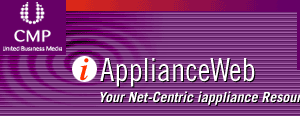



 |
 |
|
|
 |

|
||
|
|
|
|
|||

|
Software technologist sees cellular shakeup comingBy Rick Merritt, EET New chip and handset players will unseat today's cellular leaders as the rise of digital data forces an industry restructuring, according to Thomas Reardon, recently named co-chief technology officer of Openwave Systems Inc. (Redwood City, Calif.). Openwave makes browsers and other software that runs on as many as 120 million cellphones today, and hopes to capitalize on their continuing advancement. A former lead developer of Microsoft Corp.'s Internet Explorer browser, Reardon's views are colored by his PC experience. EE Times: What technology shift do you see in cellular? Thomas Reardon: Innovation away from the radio is very important. The people who understood radio, battery management and baseband were the ones who led the [cellular] industry. It was really built on the back of Motorola technology. Now it's the compute side of the phone with its graphics and sound effects that matters. People like Motorola who dominated when radio was the main technology at first just tried to strap the Internet onto their phones. They added a text browser and said you have the Internet. Our software now supports traditional Web standards like HTML and cascading style sheets for the first time. The phones for the first time have color screens of good color depth and size, CMOS sensors and polyphonic sound. All of a sudden we are ready to deliver at least some of the promise of Internet on your phone. EET: Who will be next leaders in cellular? Reardon: I spent the afternoon yesterday getting up to speed on what Intel is doing. It's exciting to see a traditional PC player who understands true dense chip design and mainstream scale start to become a more significant player in this space. People think of them as having non-presence [in cellular], but they have this tiny little $3 billion mobile chip business. I don't know who's bigger. They have a goal of driving mobile to be half their business, which I think is achievable. Their strategy of integrating flash and baseband into one package is the right one. With the Xscale and StrongARM [processors] they have been in the PDA-and-up space. What I hope with Manitoba [Intel's cellular baseband chip, due later this year] and its follow-ons is that they go very, very broad and into the mass market. That has a huge advantage to us. It will put wind at our back. I would hope they create innovation pressure in the market that would be relentless and wonderful. Nobody did Microsoft more favors than Intel, and I hope Intel does the same for us in terms of bringing the technology to the mass market. EET: What's happening among cellular handset makers? Reardon: We are at the front end of a trend where the percentage of phones sold worldwide is shifting toward Asian manufactures - especially those in Japan and Korea - because of their integration and price leverage. That shift to Asian-built phones and away from traditional European and U.S. phones is a big, big trend for us. For instance, the Nokia camera phone retails for $800. Sharp's phone is much cheaper, with a nicer screen and it's a phone not a PDA. It's the Sharp CCD, Sharp screen and plastics. They are getting the benefits of density of their intellectual property and componentry on their phone. EET: Why do you think the Asian OEMs will succeed in cellular? Reardon: If you are Sharp or Sony and did really well in the video camera business, cameras and displays on phones should threaten you. You should be scared to death of them because these handhelds will decimate the low-end digital camera market. There is no reason to own a $200 digital camera if you have this VGA color camera with great color depth on your cellphone. This is the Kodak $10 throwaway camera killer. So if you have all this IP in building digital cameras, building such phones is how you re-purpose it. EET: When will these camera phones come to the United States? Reardon: You'll see $250 phones with cameras this fall in the U.S. from just a couple vendors. I think you wont get to a mass market until they get under $150, and that wont be until the end of next year. We'll also be part of several camera phones rolling out this fall in Europe. EET: What about the so-called smart phones with PDA features? Reardon: I'm skeptical of high-end Microsoft Stinger phones and the Nokia 9000 at $800. I don't care about PDAs. That's a market shrinking by 20 percent quarter-to-quarter for the last two quarters. I care about phones. We have an addressable mass market of 320 million out of 400 million shipping cellphones this year. That's interesting. EET: How are graphics different in this next wave of phones? Reardon: You see people going from lines of text to icons. They use drop-down menus, home pages with graphics. MPEG-4 video is coming and we will make direct investments in it. We will do tight integration with the Real Networks' mobile media player. We are doing direct investment in Macromedia Flash and 3-D software libraries. There's definitely a lot of industry investment right now to see if there will be an Nvidia [PC graphics chip maker] and DirectX [PC graphics API] of the mobile space. It's still unclear yet what will happen. We are more focused on the pure compute side, whether our target is an ARM 9 or dialed-up ARM 7 or an Xscale chip that could be mass market like the upcoming Manitoba from Intel. We are very effective on an ARM 7 at 30 MHz. When you get up to an ARM 9 you can do incredible graphics libraries with alpha blending and great rotation - a PC graphics world. The other interesting thing for us is flash densities, the kinds of flash or SRAM or DRAM that's being used. This is a market where power matters. When you talk about a seven-gate-per-bit versus three-gate-per-bit RAM solution, it changes the whole game. A doubling of RAM density can create a ten times larger market for us. EET: What about Java? Reardon: I predict Java will be the Win-32 of the phone, not Qualcomm's Brew, Microsoft's .Net or Symbian. That doesn't mean everything will be written in Java. The browser captures the vast majority of applications. It's the front end. That which doesn't fit into the browser - where you need a richer environment to store something or stream media - that's where Java will play. EET: Will phones need Java hardware acceleration? Reardon: The jury is still out. What we have figured out so far is hand-tuning Java MIDP [mobile information device profile] classes gives us a whole lot. The trend on the phone is to execute-in-place code, not using RAM. That's certainly what Intel wants to do. That doesn't favor Java so much as native code executing in place. That's a tension that will be interesting to watch play out. As we get to Java MIDP-2 and we see apps that run over the network and are not just downloaded, such as interactive games that want to use 3D, we could see an effort creep back in to get Java acceleration. EET: What's the focus of your version 7 software set for next year? Reardon: It's basically making the browser OEM-friendly to let them reuse our IP to have common look and feel across the phone, which is what you need in this consumer electronics market. We're also adding JavaScript to the phone. This way the phone will not be just a rendering canvas, but you can do something on it. That local intelligence will be huge to make up for what is basically a narrow data pipe into the phone. And we have to stop the endless duplicating of code. We have three rendering engines now - the native, browser and Java rendering engines. It's time to stop that and create a much more cohesive environment. We will also have a massive graphics upgrade with flash animation even for a low-speed CPU. EET: What's the outlook for the transition to cellular data networks? Reardon: No one seems to be slowing down CDMA 1X or GPRS [general packet radio services] deployments at all. What's happening is a slowdown of 3G and some severe indigestion in Europe, in particular in 3G debt. There's a mind-boggling debt in 3G spectrum in Europe that's unheard of in corporate history. Still, the ability to get reasonably priced data services to the market is important. Carriers are predicting that real voice minutes that affect their capacity planning will erode by 5 percent a year. They just want data growth to be better than the voice erosion. If they get data to grow 25 percent a year they will be ecstatic. I think they will do better than that. EET: Any bellwethers to watch? Reardon: Sprint, Sprint, Sprint, Sprint and Sprint. They are a big one. Ultimately I think most carriers will spend a similar amount as Sprint in terms of actual infrastructure. In Europe, watch the wave of photo messaging phones, including those from Vodaphone and their big relaunch coming this fall. Vodaphone will be the key for us in GSM. EET: What's become of the Wireless Application Protocol that your company pioneered? Reardon: We're probably as much at fault as anybody because we put a hype wave on WAP that was one of the most extraordinary bubbles waiting to happen that has ever been forced into a tech community. We told everyone they were going to get Internet on the phone; in Europe they got so excited about it that they turned it into a brand, and there were logos in stores for WAP. Europe also had the worst possible network - GSM. It was great for interoperable phone calls and short message system traffic, but terrible for data. If you want to start a little browser on your phone and get some Web content you have a 30-second wait just to connect for the first time and each time you wanted to reconnect after that. You pay by the minute. There are no packets. It's circuit switched. It was a miserable experience. We had what we called WAP-lash. People walked away. EET:: What happened then? Reardon: We just did the old Microsoft thing of staying at it and doing the next version and the next version, grinding them out. They say for Microsoft it takes three versions to get it right. For us it took six. We are now in what I call the WAP-2 wave. It started with [Japan cellular carrier] KDDI and is now flowing to the rest of the world. WAP is not going away and being replaced by something else. For instance, Multimedia Messaging System is the buzz in Europe right now. Everyone is talking about moving from SMS to MMS for capturing more revenue per message, with picture messaging at the heart of it. MMS is WAP. The MMS technology stack is essentially WAP, the WAP transports and WAP push. |
|
||||||||

Terms and Conditions Privacy Statement |
||||||||||